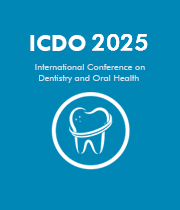Jaap Boehmer, Rijnstate Hospital, Netherlands
In the Netherlands, Prevention in Medicare is important. In the presentation is shown how it is done in Health care in General Medicine. Non smoking actions, Covid vaccination maesures and long Covid treatment. Also,critical percentages of vaccinations of, Babies and Yo [....] » Read More

































Title : Diagnosis of selected dental conditions with similar pain characteristics: Do we need to redefine our terminology? A personal view
David Geoffrey Gillam, Queen Mary University of London, United Kingdom
The aim of this presentation is to highlight the problems that clinicians may have in diagnosing dental conditions, particularly those conditions with similar pain symptoms. One of the problems confronting the clinician when attempting to diagnose different dental conditions is t [....] » Read More
Title : Temporomandibular dysfunction - The great imposter
Patrick Grossmann, British Society for the Study of Craniomandibular Disorders, United Kingdom
TMD is a subject of enormous significance, all too often misdiagnosed. Controversies surrounding TMD has caused many clinicians to shy away from treating these patients. This presentation, including several clinical cases will cover the following: - signs/symptoms of TMJ disorde [....] » Read More
Title : Oral microbiome in health and disease
Zvi G Loewy, New York Medical College, United States
Will be Updated Soon...
Title : Facial trauma 2025
Steven J Traub, American Institute of Oral Biology, United States
Will be Updated Soon...
Title : Modern temporomandibular joint surgery
Steven J Traub, American Institute of Oral Biology, United States
Will be Updated Soon...
Title : Avoiding and managing complications in implant dentistry
Mohamed Attia, Alexandria Center of Dentistry, United States
Avoiding dental implants complications requires a comprehensive approach that integrates surgical precision with restorative foresight. The key to minimizing complications lies in placing implants with a clear understanding of the final restorative outcome. This involves meticulo [....] » Read More
Title : Service evaluation of mandibular third molar coronectomy
Zayaan Humdani, University College London Hospitals NHS Foundation Trust, United Kingdom
Objectives: Coronectomy is an alternative treatment to extraction when managing non carious mandibular third molar teeth, which are in close proximity to the Inferior Alveolar Nerve (IDN). The procedure is considered a risk-reducing strategy to prevent temporary or permanent neur [....] » Read More
Title : Preserving missing spaces or creating stabilisation cases? - a cautionary example in the use of VFRs for hypodontia management
Sarah Morgan, Bart's Health Trust, United Kingdom
My case based presentation examines the use of Vacuum Formed Retainers (VFRs) in managing hypodontia, highlighting their benefits and potential risks. VFRs are clear, removable retainers commonly used after orthodontic treatment to maintain alignment and prevent relapse. In hypod [....] » Read More
Title : The use and evolution of 3D printed surgical decompression devices in the management of large apical lesions : A case series
Yogesh Patel, Barts Health NHS Trust, United Kingdom
Aim: To describe the use of a digital workflow in the management of large periapical lesions with the use of 3D printed decompression devices using a case series. Summary: The development of periapical pathology is influenced by a variety of factors such as local microbiol [....] » Read More
Title : The use and evolution of 3D printed surgical decompression devices in the management of large apical lesions : A case series
Asmah Omrani , Barts Health NHS Trust, United Kingdom
Aim: To describe the use of a digital workflow in the management of large periapical lesions with the use of 3D printed decompression devices using a case series. Summary: The development of periapical pathology is influenced by a variety of factors such as local [....] » Read More
Title : The MFS philosophy: A causal approach to craniofacial growth and development through myofunctional stimulation
Monika Osko, Barcelona Orthodontic World Institute, Spain
This presentation explores the MFS (Myofunctional Stimulation) philosophy as a causal and interdisciplinary approach to craniofacial growth and development. It begins with an introduction to the historical background and global adoption of the MFS approach, emphasizing its holist [....] » Read More
Title : Novel technique in the management of intraoral alkali-induced chemical burn
Veronika Agnes Jancsik, University of Szeged, Hungary
The composition of the oral mucosa and skin may bearing little resemblance, however the responses of the oral mucosa to burn injuries resulting in different histopathological and clinical consequences. The unique biology and localization of the oral mucosa requires an altogether [....] » Read More
Title : Contemporary orthognathic surgery in the treatment of dentofacial deformities
Rodrigo Alberto Cenci, Unochapeco - Universidade Comunitaria da regiao de Chapeco, Brazil
The number of patients receiving the benefits of orthognathic surgery has grown exponentially. Currently, the indications are not restricted only to occlusal improvement, but also an improvement in facial aesthetics and mainly respiratory improvements. Significant advances in sur [....] » Read More
Title : Hospital dentistry in the ICU: A reality in Brazil
Anna Paula Natividade de Almeida Goncalves, Complexo Americas Hospitals Samaritano Barra e Vitoria, Brazil
The critically ill patient admitted to an Intensive Care Unit (ICU) faces a series of challenges that can significantly impact their health. The severe physiological changes that occur in the body during hospitalization can be exacerbated by the presence of an inflection foci or [....] » Read More
Title : Anterior loop connector fixed partial denture – A case report
Alok dwivedi, Najran university, Saudi Arabia
In modern times everyone is more esthetic and health conscious than ever before therefore, premature loss of anterior teeth has negative psychological impact on any young individual. Among many complex prosthodontic situations posing difficulty in obtaining optimum esthetics, sat [....] » Read More
Title : Principles & planning of clear aligners: An integration to streamline treatment and increase predictability
Ali Hassan Ahmad Alhayzaee, King Faisal Medical city, Saudi Arabia
No doubt that clear aligner treatment is one of the fastest growing sectors in the dental industry. This highly demanded treatment by patients makes orthodontists to think broadly and deeply in expanding their knowledge and practice of this relatively new technology. When I start [....] » Read More
Title : Synergistic effect of platelet rich plasma with hyaluronic acid injection following arthrocentesis to reduce pain and improve function in TMJ osteoarthritis
Ayman Hegab, AL-Azhar Univeristy, Egypt
Aim of investigation: This study aimed to deter mine whether injection of PRP+HA following arthrocentesis reduces pain and improves maximum incisal opening. Methods: This was a single-blind, prospective, randomized control study. The patients were selected based on the Hegab cla [....] » Read More
Title : Esthetic and management of congenitally missing anterior teeth
Abu Hussein Muhamad, Aesthetics Dental Clinic, Greece
Congenitally missing anterior teeth alters the patient's physiognomy and diction in a big way. Maxillary incisor agenesis, prominently the lateral incisor is the most common congenitally missing permanent tooth, in the anterior maxillary region, which is the esthetic zone, re [....] » Read More
Title : The endodontic management of a dilated odontoma: A case report
Yogesh Patel, Barts Health NHS Trust, United Kingdom
Aim: To outline the endodontic management of a dilated odontoma with an orthograde and retrograde approach, utilising CBCT imaging and 3D-printed models to aid in the treatment planning process. Summary: This case describes the management of a 15-year-old female patient that was [....] » Read More
Title : The endodontic management of a dilated odontoma: A case report
Asmah Omrani , Barts Health NHS Trust, United Kingdom
Aim: To outline the endodontic management of a dilated odontoma with an orthograde and retrograde approach, utilising CBCT imaging and 3D-printed models to aid in the treatment planning process. Summary: This case describes the management of a 15-year-old female patie [....] » Read More